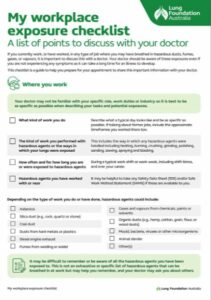If you work or have worked in environments where you may have inhaled hazardous dusts, fumes, gases, or vapours, it is crucial to inform your doctor. Even if you are not experiencing symptoms, these exposures can lead to illnesses that develop over time. This checklist will help you prepare for your appointment and ensure you share all necessary information with your doctor.
Where You Work
Be specific about your role, work duties, and industry. Describe your tasks and potential exposures in detail.
What Kind of Work You Do
Explain a typical day and include details about former jobs, including timeframes.
Exposure to Hazardous Agents
Detail how you handled hazardous agents, such as heating, burning, crushing, grinding, polishing, sanding, sawing, spraying, and blasting.
Frequency and Duration of Exposure
Specify how often and for how long you were exposed during work shifts and over your career.
Types of Hazardous Agents
List the hazardous agents you have worked with or near, such as:
- Asbestos
- Silica dust
- Coal dust
- Hard metals or plastics dust
- Diesel engine exhaust
- Welding or solder fumes
- Chemical, paint, or solvent vapours
- Organic dusts (e.g., hemp, cotton, grain, flour, wood)
- Mould, bacteria, viruses
- Animal dander
Control Measures in Your Workplace
Describe the control measures used to reduce exposure, such as ventilation, exhaust systems, wet cutting practices, PPE, shift times, and hygiene practices.
Health Monitoring
If you have undergone health monitoring, bring any results to your appointment. Health monitoring involves regular check-ups to detect changes in health due to exposure.
Symptoms
Note any symptoms, when they started, and if they improve when away from work. Mention if colleagues have similar symptoms or diagnoses.
Hobbies and Smoking/Vaping
Inform your doctor about hobbies that expose you to hazardous agents and your smoking or vaping history.
Was this page helpful?
Good job! Please give your positive feedback
How could we improve this post? Please Help us.




